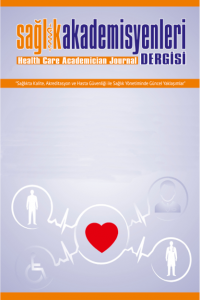Akademisyenlerin Aşı Karşıtı ve Akılcı İlaç Kullanım Davranışlarının Değerlendirilmesi: Kesitsel Bir Çalışma
Akademisyenler, aşı karşıtlığı, davranış, COVID-19, akılcı ilaç kullanımı
Evaluation of Academics' Anti-vaccination and Rational Drug Use Behaviors
Academics anti-vaccine, behavior, COVID-19, rational drug use, rational drug use,
___
- 1.Hussain A, Ali S, Ahmed M, Hussein S. (2018). The anti-vaccination movement: a regression in modern medicine . Cureus; 10(7): e2919. DOI 10.7759/cureus.2919
- 2.Shen S, Dubey V. (2019). Addressing vaccine hesitancy. Canadian Family Physician; 65 (3):175-181.
- 3.Herrera-Peco I, Jiménez-Gómez B, Romero Magdalena CS, Deudero JJ, García-Puente M, Benítez De Gracia E, Ruiz Núñez C. (2021). Antivaccine Movement and COVID-19 Negationism: A Content Analysis of Spanish-Written Messages on Twitter. Vaccines; 9, 656. https:// doi.org/10.3390/vaccines9060656
- 4.Germani F, Biller-Andorno N. (2021). The anti-vaccination infodemic on social media: A behavioral analysis. PLoS ONE; 16(3): e0247642.
- 5.Kader Ç. (2019). Anti-vaccination: vaccine hesitancy and refusal. ESTÜDAM Halk Sağlığı Dergisi; 4(3): 377-88. https://doi.org/10.35232/estudamhsd.590304
- 6.Dubé È, Ward JK, Verger P, MacDonald NE. (2021). Vaccine hesitancy, acceptance, and anti-vaccination: trends and future prospects for public health. Annu. Rev. Public Health; 42:175–91.
- 7.Shi J, Ghasiya P, Sasahara K. (2021). Psycho-linguistic differences among competing vaccination communities on social mediaarXiv:2111.05237v1.
- 8.Akyüz SS. (2021). The role of communication practices and political affiliations in anti-vaccine attitude and transparency perception, e-Journal of New Media; 5 (2): 172-185.
- 9.Keelan J, Pavri-Garcia V, Tomlinson G, Wilson K. (2007). YouTube as a source of information on immunization: a content analysis. JAMA; 298: 2482-84.
- 10.Motta M, Callaghan T, Sylvester S, Lunz-Trujillo, K. (2021). Identifying the prevalence, correlates, and policy consequences of anti-vaccine social identity. Politics, Groups, and Identities; DOI: 10.1080/21565503.2021.1932528.
- 11.Sema FD, Asres ED, Wubeshet BD. (2021). Evaluation of rational use of medicine using WHO/INRUD core drug use indicators at Teda and Azezo Health Centers, Gondar Town, Northwest Ethiopia. Integrated Pharmacy Research and Practice; 10: 51–63.
- 12.Yang H, Chen Y. (2021). Analysis on the problems of rational drug use carrying out by hospital pharmacists in China. Open Journal of Preventive Medicine; 11: 251-258.
- 13.Özdamar EN, Mutlu HH. (2021). Evaluation of the rational drug use by using the World Health Organization core prescribing indicators at the obesity outpatient clinic of a tertiary care hospital. Ege Journal of Medicine; 60 (1): 13-19.
- 14.WHO. (2002). Promoting rational use of medicines: core components. WHO Policy Perspectives on Medicines.
- 15.Khan Z, Karatas Y. (2021). Irrational drug usage in Turkey: The need for more active educational intervention among health care professionals and patients. Anatol J Family Med; 4(2):199–200.
- 16.Anonymous. (2021). Türk üniversitelerindeki kadın profesör oranı, Avrupa ortalamasını geride bıraktı. Yükseköğretim Kurulu (YÖK), Ankara.
- 17.Kılınçarslan MG, Sarigül B, Toraman C, Sahin EM. (2020). Development of valid and reliable scale of Vaccine Hesitancy in Turkish language. Konuralp Medical Journal; 12(3): 420-29.
- 18.Demirtaş Z, Dağtekin G, Sağlan R, Alaiye M, Önsüz MF, Işıklı B, Kılıç FS, Metintaş S. (2018). Akılcı ilaç kullanımı ölçeği geçerlilik ve güvenilirliği. ESTÜDAM Halk Sağlığı Dergisi; 3(3): 37-46.
- 19.Tabachnick BG, Fidell LS. (2013). Using multivariate statistics (6th ed.). Allyn and Bacon, Boston.
- 20.Karakurt P, Hacıhasanoğlu R, Yıldırım A, Sağlam R. (2010). Medication use among university students. TAF Prev Med Bull; 9(5): 505-512.
- 21.Akıcı A, Uğurlu MÜ, Gönüllü N, Oktay Ş, Kalaça, S. (2002). Pratisyen hekimlerin akılcı ilaç kullanımı konusunda bilgi ve tutumlarının değerlendirilmesi. Sürekli Tıp Eğitimi Dergisi (STED); 11: 253-7.
- 22.Kıroğlu O, Berktaş F, Şahan E, Karataş Y. (2018). Knowledge and attitudes of research assistants about rational drug use. Cukurova Medical Journal; 43(1): 164-171.
- 23.Dutta A, Chakraborty S. (2010). Practice of rational drug uses in a rural area of 24 pgs(s) in West Bengal. J. Adv. Pharm. Tech. Res; 1(3): 358-364.
- ISSN: 2148-7472
- Yayın Aralığı: Yılda 4 Sayı
- Başlangıç: 2014
- Yayıncı: Dünya Kongre
Gelişmekte Olan Ülkelerin Sağlık Sistemi Göstergelerinin Karşılaştırmalı Analizi
Canser BOZ, Salim YILMAZ, Haluk ÖZSARI
Esin TEMELOĞLU ŞEN, H. Özlem SERTEL BERK, Dilsad SİNDEL
Mansur Seymen SEĞMENOĞLU, Hilal KUŞCU KARATEPE
ÖDEME GÜÇLÜĞÜNE BAĞLI KARŞILANAMAYAN TIBBİ BAKIM İHTİYACI
Melek TERZİ, Mehmet Nurullah KURUTKAN, Dilek ŞAHİN, Oğuz KARA
OBSTETRİDE VE JİNEKOLOJİDE APİTERAPİNİN KULLANIMI
Shaira . RAHİMJANOVA, Hüsniye DİNÇ, Sevil GÜNAYDIN
Anemide Gebelik Sonuçları ve Bakım
PATOLOJİ LABORATUVARINDA MAKROSKOPİ TEKNİKERİNİN ROLÜ
Mustafa HÜZ, Kutsal YÖRÜKOĞLU, Nusret AKPOLAT
Atikullah GHİASEE, Merve KARAKAŞ
OTOİMMÜN TİROİDİTİ OLAN HASTALARDA PREMATÜR OVARYAN YETMEZLİK SIKLIĞI
Ceren YILDIZ EREN, Hulusi Göktuğ GÜRER, Özlem ÖZGÜR GÜRSOY, Ozge GODEK
Sağlık Kurulunda Çalışanların İletişim Sorunları ve Çözüm Önerileri Üzerine Nitel Bir Araştırma
